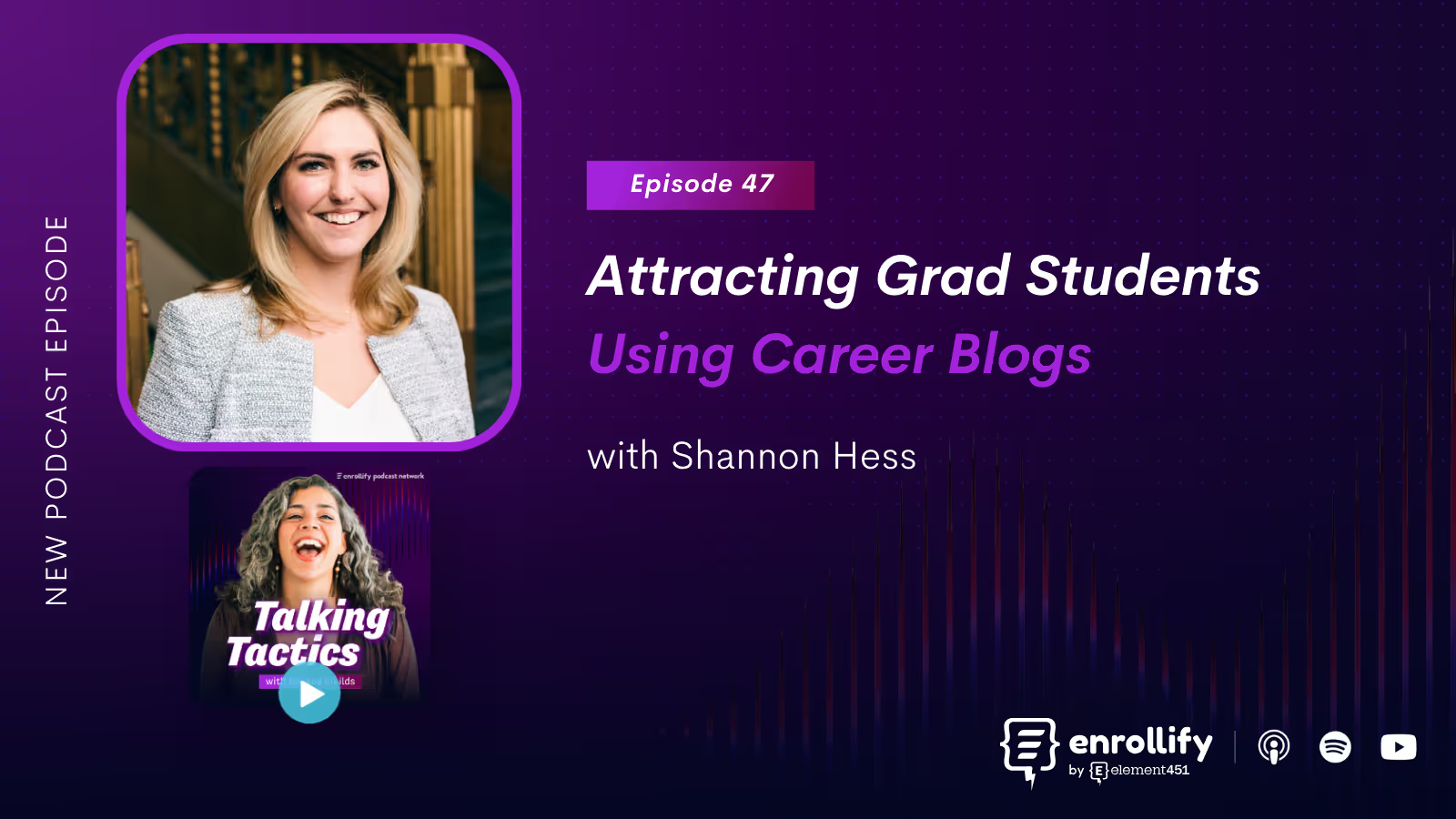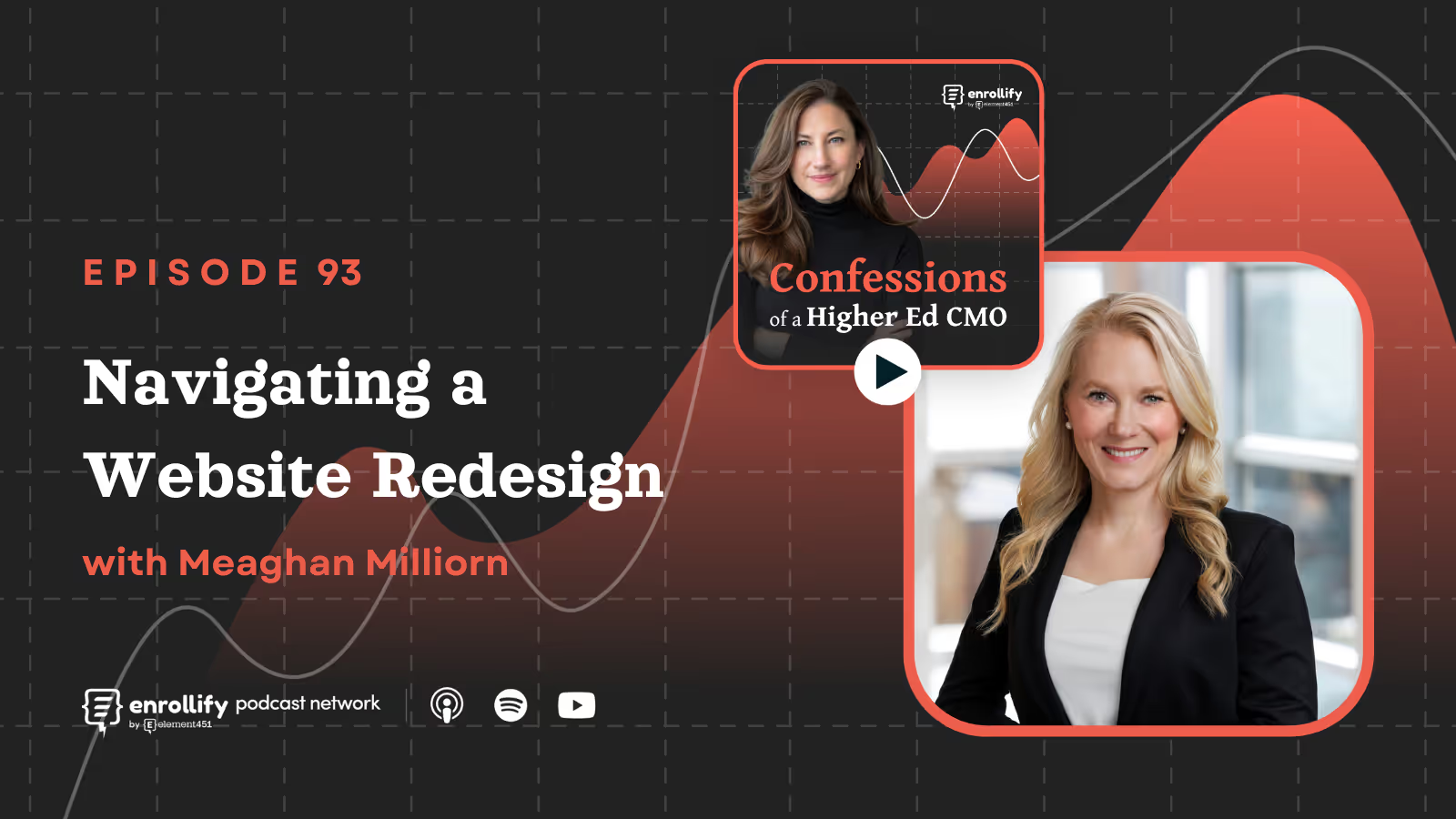About the Episode
Got a story to tell? An innovative idea to share? Fill out our guest nomination form and let's chat!
About the Episode:
Graduate programs often focus on outbound marketing, but what about capturing students who are deciding whether to go back to school in the first place? Purdue Business found a solution that works—blogging.
Shannon Hess, Director of Content and Communications at the Mitch Daniels School of Business, shares how launching a prospective graduate student blog led to a 425-keyword increase in non-branded organic search rankings, 680 additional website sessions per month, and 400+ new website visitors each month.
In this episode, Shannon walks us through the exact steps Purdue Business took to create a blog that drives real results, from SEO strategy and topic clustering to content creation workflows, and how AI can help. If you're looking to attract highly motivated prospective grad students, this episode is for you.
✔️ Follow Shannon Hess on LinkedIn.
✔️ Subscribe to Talking Tactics for more real-world higher ed marketing tactics that actually work.
✔️ Attending CASE District V or EDUweb Summit? Catch Shannon’s presentations for more insights on blogging and SEO.
✔️ Want to see the Purdue Business blog in action?
https://business.purdue.edu/graduate-programs/blog/
Why Did Purdue Business Start a Graduate Blog?
When Shannon Hess joined Purdue Business, she identified a major gap in their content strategy—there was strong mid-funnel content (consideration stage) and robust outbound digital ads, but very little organic top-of-funnel content. Prospective students weren’t just searching for programs; they were asking questions like:
- Should I go to business school?
- What careers can I get with a finance degree?
- Is an MBA worth it for career advancement?
By not addressing these initial questions, Purdue Business was missing out on engaging students before they even considered applying. Shannon, leveraging her inbound marketing expertise, saw an opportunity to build an SEO-driven blog to attract high-intent, organic traffic and nurture these prospective students.
How Did They Launch the Blog?
Once they identified the need, the Purdue Business team took the following steps:
- Worked with their web director to find an easy way to implement the blog within their existing website structure.
- Used SEMrush to conduct SEO research and identify relevant keywords and content clusters.
- Started with career-focused content, answering common industry questions and linking them to related academic programs.
- Created a structured editorial workflow, assigning a lead writer, interns for research and interviews, and an internal editor.
- Ensured content equity across programs, rotating topics based on student interest, search demand, and institutional priorities.
How Did They Choose Blog Topics?
The Purdue Business team focused on content clustering, starting with career-related topics and expanding into student experiences and transformational learning. Examples of early blog topics included:
- "Should You Become an Auditor?"
- "What Does Commercialization Mean?"
- "How a Master's in Business and Technology Prepares You for a FinTech Career"
They prioritized non-branded, high-intent search terms to capture organic traffic from students who weren’t yet considering Purdue specifically.
What Were the Biggest Challenges?
- Maintaining consistency – While their goal was two blogs per month, managing interns and student contributors required flexibility.
- Balancing content across programs – Some academic leaders questioned why certain topics were prioritized, so the team had to ensure equity while aligning with institutional goals.
- Educating stakeholders on SEO value – Proving that non-branded keyword traffic leads to conversions was crucial for securing ongoing buy-in.
What Results Have They Seen?
Since launching the blog, Purdue Business has experienced:
- A 425-keyword increase in non-branded search rankings
- 680 additional website sessions per month
- Over 400 new visitors monthly
- Significant improvements in organic traffic quality – Visitors from search were more engaged and more likely to convert.
One of their best-performing blog posts, “Should You Become an Auditor?” skyrocketed to the #3 traffic-driving page within just a few months, proving the power of well-targeted SEO content.
How Else Is the Blog Content Being Used?
- Social media – High-performing blogs are regularly shared across Purdue Business’s social channels.
- Email marketing – Blog content is integrated into nurture campaigns and enrollment communications.
- Content repurposing – Insights from blog posts fuel webinars, faculty research highlights, and student testimonial pieces.
Final Advice for Higher Ed Marketers
Shannon’s biggest piece of advice? Take it one step at a time. SEO is a long game, but every small win compounds over time. She also suggests:
- Start with web infrastructure – Work with IT early to ensure smooth implementation.
- Use SEO research tools – Free or paid, they help validate what students are searching for.
- Leverage AI where possible – AI tools can help brainstorm content ideas and research questions.
- Trust the process – Non-branded SEO content might not seem valuable at first, but it attracts highly motivated prospects who are more likely to convert.
Attend the 2025 Engage Summit!
The Engage Summit is the premier conference for forward-thinking leaders and practitioners dedicated to exploring the transformative power of AI in education.
Explore the strategies and tools to step into the next generation of student engagement, supercharged by AI. You'll leave ready to deliver the most personalized digital engagement experience every step of the way.
👉🏻 Register now to secure your spot in Charlotte, NC, on June 24-25, 2025!















